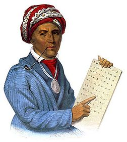

Exploring our past to sort out myth from reality
Share this Page on
Facebook or Twitter

These are the voyages of the TimeShip Anachron.
Our Mission: To boldly explore the past, dispelling
mythinformation and mythconceptions
of American History along the way.
 Visit us on Facebook
Visit us on Facebook


These are the voyages of the TimeShip Anachron.
Our Mission: To boldly explore the past, dispelling
mythinformation and mythconceptions
of American History along the way.

Exploring our past to sort out myth from reality
Share this Page on
Facebook or Twitter
 Visit us on Facebook
Visit us on Facebook
Meet MythAmerica Series

Pt 1 Pt 2 Pt 3 Pt 4 Pt 5 Pt 6 Pt 7
Walk 1000 Miles in My Moccasins
I would suppose that a large number of Americans are familiar with the term "Trail of Tears," but I'm suspicious that their familiarity with what it refers to is often very sketchy. The story of the forced removal-on foot-of the Cherokee from their homelands in the Eastern US to reservations a thousand miles away in Oklahoma "Indian Territory" in the early 1800s seldom merited more than a sentence or two-if that-in basic grade school or high school American history books until recent times. Even my college-level American history classes in the late 1960s, designed to prepare future history teachers, totally neglected the topic. The Native American civil rights movement of the 1970s brought a bit of notoriety to the saga, including a few documentary books and a TV documentary, but those faded from view shortly after. This Meet MythAmerica series is dedicated to providing an in-depth look at the circumstances and events that led up to this shameful chapter in America's story, along with an overview of what the trek was like. And it concludes with an examination of the lessons that should be learned from both the event-and the way it was ignored for almost a century and a half in the standard American Narrative passed on to America's youth.
Part 1: On the Trail of a Major Story
This introductory entry to the Trail of Tears series shares details about one of the men who eventually became a key player in the saga, Major Ridge
Part 2: Livin' the American Dream
This article describes the lifestyle of the Cherokee Indians of Northern Georgia in the early 1800s, including their attempts to adapt to a "white man's culture."
Part 3: Catchin' the American Dream
This entry in the Trail of Tears series continues the description of the attempts by the Cherokee to align their way of life with the expectations of the governmental leaders in Washington, in order to "qualify" for inclusion in the growing American Dream. It concludes with the failure of their efforts and an introduction to the plans of the Indian Removal Act.
Part 4: Death of an American Dream
This entry in the Trail of Tears series chronicles the efforts-and the failure-of both the Cherokee and their allies among the White Man to change the mind of the leaders of the US Government regarding the Indian Removal Act.
Part 5: The Nightmare Begins
This entry in the Trail of Tears series begins the description of the cruel round up of the Cherokee families who were to be evicted from their homeland…men, women, children, infants, the elderly. About 13,000 eventually were confined to stockades awaiting their departure.
Part 6: The Nightmare Continues
This entry in the Trail of Tears series completes the description of the hellish journey the Cherokee were forced to endure. Also discussed are the pathetically meager efforts in recent decades to provide some sort of appropriate memorial to the saga.
Part 7: Back to the Bible
This concluding entry in the Trail of Tears series examines some poignant passages from the Bible that are applicable to the circumstances of the saga. It is intended to prod those Americans who may adamantly hold to the theory that, until very recently, America has always been a "Christian" nation, its government guided by "Christian" principles, its people proud to be God's "example to the world" of "a nation whose God is the Lord"… to match up their theory with some historical reality.






